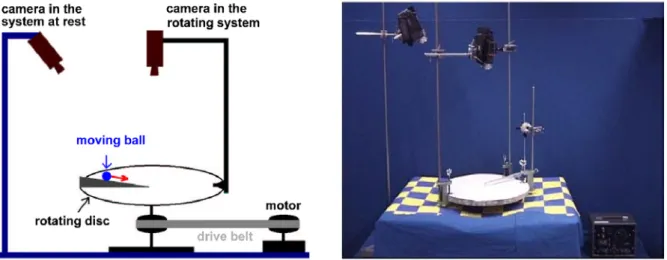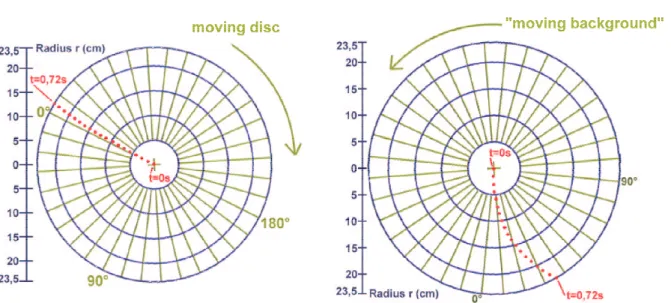Multimedia in physics education: a video for the quantitative analysis of the centrifugal force and the Coriolis force
Andreas Wagner, Stefan Altherr, Bodo Eckert and Hans Jörg Jodl
Department of Physics, Technical University of Kaiserslautern, Erwin-Schrödinger-Straße, D- 67663 Kaiserslautern, Germany
E-mail: eckert@physik.uni-kl.de
Abstract
A digital video on forces occurring in rotating frames of reference is presented. It allows stu- dents to observe and to analyze the trajectory of one and the same moving ball in both sys- tems, the laboratory system at rest and the rotating system. An application of the video for physics exercises in the first year of physics study is outlined.
PACS 01.50.Fr (Audio and visual aids, films)
Keywords
multimedia, physics education, centrifugal force, Coriolis force, frames of reference
The topic around Coriolis force (such as linearly accelerated and rotating frames of reference, inertial reference frames, fictitious or inertial forces) plays a major role in teaching mechanics. The phenome- non itself occurs in nature, in technical applications as well as in everyday life.
But as experience tells us, learners do have difficulties in general to understand this concept (here transformation of coordinates): one reason could be because the demonstration experiments in class are unclear (e.g. Foucault pendulum); another reason could be because static representations in physics books are misleading or simply wrong; or that text books sometimes persuade the reader as if fictitious forces are not really existing/acting forces. In addition, the observer (pupil or student), watching such a demonstration experiment, is located in the coordinate system at rest (laboratory system), whereas the Coriolis force acts and can be visualized only in the accelerated coordinate system. Several “tricks”
are known in specially designed demonstration experiments to visualize the Coriolis force, such as pendulum filled with sand over a rotating disc or monitoring the trajectory of a rolling ball over a ro- tating disc [1]. But all those tricks require the skill of a learner to perform the transformation of the two reference frames (at rest and accelerated) quasi in its head. As teaching media we know of many convincing videos (e.g. carousel, winds around a low pressure area in the Northern/Southern Hemi- sphere). Common to all of them, the observer is located either in the rotating system or in the system at rest. Technical advantages of digital videos are not used [2].
As is well-known, the Coriolis force becomes noticeable on a body for example, if the body is moving radial with constant velocity in a constantly rotating system (i.e. this system is accelerated). From the view of the laboratory system at rest, this body is moving without forces acting on it; therefore its tra- jectory of motion is a straight line (if we neglect friction). From the view of the accelerated coordinate system the trajectory of this body will deviate from a straight line as a consequence of the additional force acting on that body. Therefore one has to monitor one and the same motion of a body from the view of these two coordinate systems (at rest and accelerated), to demonstrate clearly the difference.
This is exactly the approach of our video to realize these two “views”.
To appear in European Journal of Physics
Figure 1: Experimental set up (left: scheme, right: photo).
The experimental set up is shown in figure 1: a digital camera, fixed at the floor of the laboratory, shows the view of the coordinate system at rest; a further camera, fixed on the rotating disc, shows the view of the accelerated coordinate system. The difference in both views is very obvious in our video, because the noticeable pattern of the lab-table is at rest or rotating. The rest of the experimental set-up is known: the ball is rolling down an inclined plane; in the middle of the disc the ball leaves the in- clined plane; then the ball is rolling with a constant radial velocity (Newton’s first law:
applied to the system at rest). A motor is rotating the disc with constant frequency.
const 0⇔ =
= v F
Figure 2: Result of marked trajectory of one and the same motion (left: view in the lab system at rest, right: view in the accelerated system).
The result is shown in figure 2. One and the same trajectory of a rolling ball is viewed by the video camera at rest (left part) or viewed by the rotating video camera (right part). The video camera is tak- ing 25 pictures per second; therefore one can mark the position of the ball in the trajectory by equidis- tant points for visualization.
We are producing our teaching videos in such a way, that the observer can simply watch the video (qualitative approach) or during looking at the video the observer can perform measurements (quanti- tative approach). These activities – to measure and analyze data (see figure 3 and Appendix) – are related to a specific problem, of course.
Figure 3: Analysis of the motion (figure 2) by means of a polar diagram (coordinates radius r and an- gle φ).
All necessary data/information (such as radius of disc, frequency of rotating disc, position of ball at given times) are available with this video. Therefore, the observer of this video can experimentally check the theoretical definition of the Coriolis acceleration.
This video – Coriolis and centrifugal forces – can be downloaded for free with average resolution [3]
or can be ordered from the authors on CD-ROM with higher quality [4].
Appendix
The following problem was assigned several times in exercises for physics beginners of the first se- mester at university. The solution can be obtained by contacting the authors.
Problem Rotating frame of reference
While the forces occuring in linearly accelerated frames of reference (e.g. in a lift) can be easily understood, the forces occuring in rotating systems (such as the earth) are much more difficult to understand. The term “fictitious”
may lead to misunderstanding, that such forces are not real. On the other hand, our body can experience those forces when, for example, we are moving in bus driving on a bendy road.
The video “Coriolis and centrifugal forces” shows one and the same motion of rolling ball on a rotating disc; from that one can easily conclude that it is necessary to intro- duce additional accelerations in the rotating system to describe the motion of the ball. This “fictitious” accelera- tion has to be put down to the accelerated motion of the disc, since circular motion is an accelerated one.
Your task: First, calculate the velocity 'vr and the acceleration 'ar for a moving mass in the rotating system (general). Then, determine from the data given by the video the acceleration a
and
) ' , ' , ' (
'= ar aϕ az r
'
ar of the ball when it is arriving at the border of the rotating disc.
Comments: Use cylinder coordinates (r,ϕ,z) for the calculation. Neglect the small friction of the ball’s trajectory in the system at rest. Make use of the angular velocity ωr =(0,0,−ω) for the rotating disc.
References
[1] Meiners H F (ed.) 1970 Physics Demonstration Experiments (New York: The Ronald Press Company)
[2] We mention here only a few examples for illustration: (a) Forces and Winds – Online Meteor- ology Guide (University of Illinois)
http://ww2010.atmos.uiuc.edu/(Gh)/guides/mtr/fw/crls.rxml (b) The Video Encyclopedia of Physics Demonstrations (Los Angeles: The Education Group)
http://www.physicsdemos.com/en/pdf/600Demoen.pdf http://www.physicsdemos.com/ (c) Physical Oceanography Demo Movies (Graduate School for Oceanography at the University of Rhode Island) http://www.po.gso.uri.edu/demos/ (d) Marshall J Physics of Atmospheres and Oceans - course 12.003 (Massachusetts Institute of Technology) http://www-
paoc.mit.edu/labweb/lab5/gfd_v.htm and http://www-paoc.mit.edu/labweb/lab1/gfd_1.htm (e) Physics and Astronomy Lecture Demonstrations: Coriolis Effect - 1E30.28 (University of Iowa) http://faraday.physics.uiowa.edu/mech/1E30.28.htm
[3] File size ca. 19 MB, for Real Player, http://pen.physik.uni- kl.de/medien/MM_Videos/index_eng.html
[4] File size ca. 100 MB, avi format, reimbursement of expenses 5.- €.

